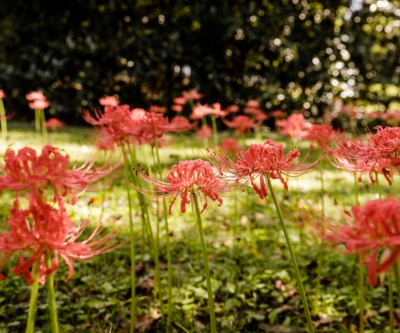“They are LYCORIS,” my friend said. “Do you know LYCORIS?”
I did not. It was my first encounter with the delicate-looking beauties. We were admiring a bright red drift of them blooming in September. I was to find out later that there are several members of the “clan,” and the one that we were admiring was Lycoris radiata, or red spiderlily, which graces many Southern gardens each year in early autumn.
And while my first notice of them was memorable, it barely prepared me for the sight of them blooming by the thousands in a grassy grove here at Hills & Dales Estate. For years they have been a near traffic stopper on Vernon Street. But recently the number of blooms has been dwindling, which has led to some research as to why this is occurring.
One thing is for sure, the bulbs are still there—plenty of them. The strain that is growing here is most likely the heirloom type, L. radiata var. radiata, which is very vigorous and multiplies readily. Although they have made themselves at home in the South over the last 200 plus years, they actually hail from Japan. Their vivid blooms are beloved September’s siren for signaling the arrival of autumn, usually following a good rain that sends their flower stalks shooting up almost overnight. The common name of “spiderlily” is apparent as the cluster of five to seven blooms open with their narrow petals and long, spidery anthers. The fact that they bloom when their foliage is not growing lends to a couple of other common names—surprise lilies and naked ladies. They may not be as precise, but common names are definitely more fun than scientific ones, don’t you agree? The narrow leaves emerge soon after the blooms are gone and remain through the winter and into the following spring before dying back. Many of the bulbs now sold as red spiderlilies are imported from their native Japan, but are actually not as desirable for Southern gardens as the heirloom. Most experts agree that what is commonly offered now is Lycoris radiata var. pumila, which is smaller, earlier blooming (by a couple of weeks) and without the same iron constitution that the old one has. Why? Well, the heirloom bulbs (var. radiata) are actually hybrids with an extra set of chromosomes, giving them stamina and extra strength. That is one reason why they reproduce so readily. Now don’t misunderstand me, var. pumila is lovely and, given the right conditions, grows and blooms nicely. It is just not able to grow and thrive under as many varied and challenging conditions as var. radiata.
This brings us back to our dilemma of dwindling numbers of blooms. The experts concede that over the years the outstanding heirloom vigor of our variety may have caused our field to become too crowded, and there may be too many bulbs competing for the same water and nutrients for prolific blooming to occur. Georgia’s recent drought of historic proportions hasn’t helped matters either. If the return to more normal levels of soil moisture and the application of some high quality organic fertilizer doesn’t do the trick, some real consideration will have to be given to a division project. The problem is that most sources and gardeners caution about disturbing Lycoris, as they sometimes take years to re-bloom after even catching sight of a fork or shovel. In addition, it will be a monumental task to undertake—they are not in a small area. We’ll keep you posted. In the meantime, if you want a splash of red in your fall garden make sure you include some red spiderlily bulbs with your next bulb order.



